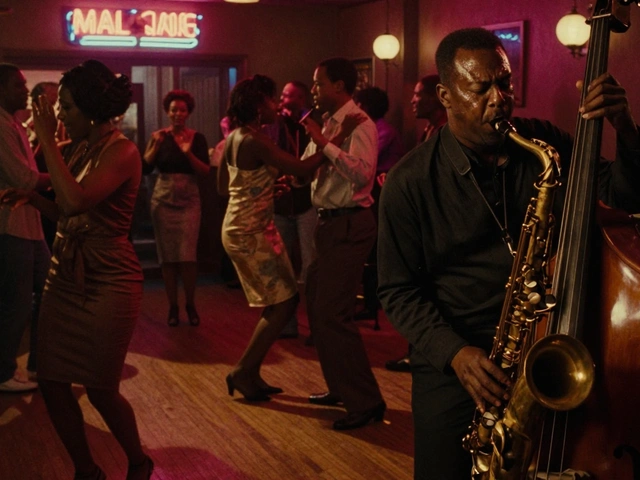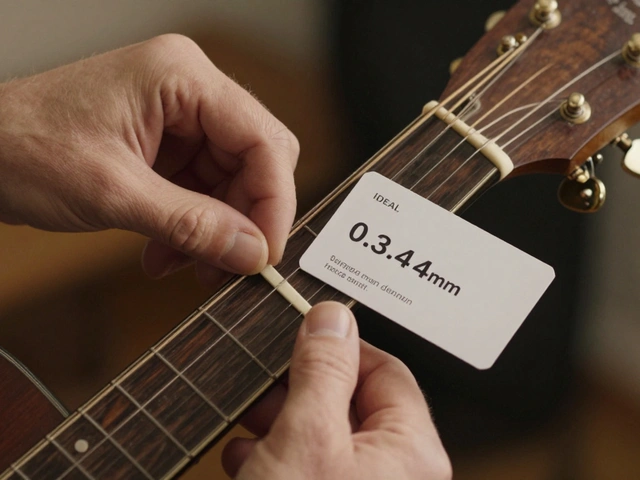The acoustic guitar feels like home in music. One strum and you get it—there’s a rawness you can’t fake, a sound that moves from your hands right to someone’s heart. Unlike electric guitars loaded with knobs and tech, acoustics keep it simple. No amp, no wires, just wood, strings, and your fingers making real sound that fills the room.
If you’re just starting out, an acoustic guitar teaches you the basics fast. You hear every note, every missed fret, and every buzz—so you learn to fix them. Plus, you don’t need much: choose a decent beginner model, keep it in tune, and you’re all set. No plug-in required. That’s probably why so many music teachers push kids toward acoustic first. There’s no hiding. You get honest feedback the second you start playing.
People love acoustic guitars because you can play them anywhere: the couch, by the campfire, in your bedroom after everyone’s asleep. No wonder they’ve never gone out of style. The songs are portable. The stories are, too.
- What Makes Acoustic Guitars Timeless
- How Acoustic Guitars Differ from Electric
- The Science Behind Acoustic Sound
- Famous Songs and Artists
- Buying Your First Acoustic: Tips
- Care and Maintenance Made Simple
What Makes Acoustic Guitars Timeless
The cool thing about acoustic guitar is how it cuts across ages, music styles, and any skill level. You’ll still see them in pop, rock, folk, country, and even hip-hop sessions. Why? That natural sound grabs people every time, no matter what year you’re in. Guitars like the Martin D-28 or Gibson J-45 have been used on hit records since the 1930s, and their designs haven’t changed much. Why mess with something that works?
Let’s look at some other reasons behind the timeless pull:
- Instant connection: When you play an acoustic, your playing style makes a huge difference to how the song feels. The sound is warm and direct, so it fits at big shows or quick jam sessions with friends.
- Zero set-up hassle: You never have to grab an amp, effects pedal, or fancy cable. Acoustic guitars work anywhere – the backyard, a school music room, or your living room.
- Bigger learning payoff: Learning on acoustic builds up finger strength and accuracy. Electric is easier on the fingers, but acoustic makes you a stronger player faster.
- Always in demand: Tons of hit songs started out with someone noodling on an acoustic in their bedroom. Producers and bands still ask for “just you and your guitar” takes even with all the tech we have now.
Take a look at how acoustic guitars stack up in the real world:
| Aspect | Acoustic Guitar | Electric Guitar |
|---|---|---|
| First appeared | Early 1800s | 1930s |
| Portability | High | Medium |
| Main use | Solo, group, songwriting | Bands, effects-driven music |
| Power needed | None | Electricity, amp |
| Annual global sales* | Approx. 1.9 million | Approx. 1.2 million |
*Source: Music Trades, 2023 Global Musical Instrument Industry Report
It says a lot that acoustic guitars are still big sellers even with all the digital stuff out there. You can pick up an old guitar at a flea market, restring it, and be part of a tradition that hasn’t faded in over 200 years. Whether you’re strumming Beatles songs, learning a Taylor Swift tune, or writing something totally original, the acoustic keeps making history. That’s not changing anytime soon.
How Acoustic Guitars Differ from Electric
If you’ve only played one or the other, you might not realize just how different acoustic and electric guitars really are. The biggest thing is that an acoustic guitar creates sound all by itself. It doesn’t need any cables, pedals, or speakers. When you pluck a string, that wooden body acts like a big speaker box and pushes sound out into the air. With an electric, the body is usually solid, way thinner, and needs an amp to be heard.
Let’s break down the main differences:
- Sound: Acoustics are louder when played unplugged and have a warm, natural tone. Electrics stay pretty quiet until you plug them in.
- Weight and Feel: Acoustic guitars are bulkier and usually lighter. Electrics can be hefty and are slimmer, so they feel different in your arms.
- Playability: Acoustic strings are often thicker and sit higher off the fretboard, making them tougher on new fingers. Electrics use lighter strings and often have lower "action," making things feel smoother.
- Features: Electrics come with all sorts of knobs, pickups, and switches for changing your sound fast. Acoustics pretty much just have a sound hole—what you play is what you get.
- Style of Music: Think coffeehouse for acoustics, rock concerts for electrics. But rules can always be bent.
Here's a quick comparison to give you a clearer picture:
| Feature | Acoustic | Electric |
|---|---|---|
| Body Type | Hollow (wooden) | Solid or semi-hollow |
| Average Weight | 4-6 pounds | 6-12 pounds |
| String Gauge | Usually heavier | Lighter |
| Volume (Unplugged) | High | Low |
| Gear Needed | Just the guitar | Guitar, amp, cable |
| Common Use | Folk, country, pop, songwriting | Rock, metal, blues, jazz |
A funny thing: lots of famous artists start with acoustics—even folks like Keith Richards and Jimi Hendrix got their basics down there first. Switching from acoustic to electric makes you notice just how much "help" the gear gives you. But once you handle acoustic stuff, your playing on electric usually gets way better.
The Science Behind Acoustic Sound
Ever wonder what actually makes an acoustic guitar sing? It’s not magic. It’s physics—and a bit of smart design. When you pluck a string, it vibrates and sends energy into the bridge and then into the guitar’s wooden top, also called the soundboard. This wooden plate acts like a speaker, turning tiny vibrations into the strong, rich sound you hear. The shape and material of the body shape the tone you get. That’s why even guitars from the same brand can sound a little different.
Different woods matter, big time. Spruce tops are bright and loud, while mahogany is warmer and rounder. Some people geek out about this stuff and can hear the difference instantly. For most of us, you just need to pick the one that feels and sounds right to your ears.
Let’s talk about the soundhole too—it’s not just for looks. The soundhole helps move air in and out, which boosts the guitar’s volume. The size and placement of the hole really affect how the guitar projects. Guitars with smaller or shifted soundholes have a tighter, more focused sound.
How loud does it really get? Check this out:
| Guitar Body Size | Average Decibels (dB) |
|---|---|
| Parlor | 70 dB |
| Dreadnought | 75 dB |
| Jumbo | 80 dB |
Bigger bodies like jumbo guitars crank out more sound because they can move more air. That’s why they’re popular for playing with friends or in noisy spaces.
What really sets the acoustic guitar apart, though, is the way its sound reacts to your touch. Light picking or heavy strumming both come through clear and direct with zero lag. There’s nothing digital standing in the way. So if you ever wondered why unplugged music feels more honest, it’s because every tiny thing you do with your fingers changes what people hear, right away.

Famous Songs and Artists
When you think of iconic music moments, it’s amazing how often an acoustic guitar is at the center. Some of the world’s most memorable songs were born on six strings and a wooden box. Bob Dylan, for example, used his Martin D-28 acoustic on "Blowin’ in the Wind"—that single tune changed folk music forever. Ed Sheeran, on the other hand, writes almost everything with his trusty Little Martin, bringing acoustic to today’s pop charts. Even Taylor Swift, before the stadium tours, wrote her biggest hits with just an acoustic in her bedroom.
Acoustic guitars shape not just sound, but emotions. Think of "Blackbird" by The Beatles, recorded with nothing but Paul McCartney’s fingerpicking and a soft vocal. Eric Clapton’s "Tears in Heaven" and Nirvana’s MTV Unplugged sessions prove you don’t need loud amps to strike a chord with millions of people.
“Usually the challenge with an acoustic session is to see how naked a song can sound and still be powerful.” — Dave Grohl, Foo Fighters
Here are a few famous acoustic-driven tracks and their artists:
- "Wonderwall" — Oasis
- "Good Riddance (Time of Your Life)" — Green Day
- "Hotel California" (acoustic version) — The Eagles
- "The A Team" — Ed Sheeran
- "Tears in Heaven" — Eric Clapton
Acoustic guitars are also everywhere in pop and indie charts—according to a 2023 Spotify data report, acoustic versions of popular songs had a 60% higher listener retention compared to straight studio versions. Live acoustic sessions rank among the most viewed music videos on YouTube, too—that’s real staying power.
| Artist | Famous Acoustic Song | Original Release Year |
|---|---|---|
| Bob Dylan | Blowin’ in the Wind | 1963 |
| The Beatles | Blackbird | 1968 |
| Ed Sheeran | The A Team | 2011 |
| Nirvana | About a Girl (Unplugged) | 1994 |
| Taylor Swift | All Too Well (Acoustic Version) | 2021 |
So yeah, even in an age flooded with digital beats and synths, the acoustic guitar keeps making hits. The human touch and natural sound just never get old.
Buying Your First Acoustic: Tips
Walking into a music shop and seeing rows of shiny guitars can feel overwhelming—where do you even start? First, ignore the hype and look for what fits your body and budget. The most expensive isn't always the best for you.
If you’re shopping for your first acoustic guitar, stick with well-known brands like Yamaha, Fender, and Taylor. They’re trusted for a reason and have plenty of models under $300 that sound great and last. In fact, a 2023 consumer report found Yamaha FG800 is still the most popular beginner acoustic worldwide because it’s easy on fingers and wallet.
- Size matters: Dreadnoughts are loud with a big body, but smaller ‘concert’ or ‘parlor’ guitars are lighter and easier for younger players or folks with smaller hands.
- Action check: The 'action' (distance from strings to fretboard) should be low enough to press easily, but not buzz. Ask a staffer if you’re unsure—it really helps with learning.
- Solid top vs. laminate: Solid wood tops sound richer and get better with age, though cost a bit more. Laminate tops are tougher and cheaper but offer less warmth in the sound.
- Play before you buy: If you can, try out several in the shop. Notice which one feels good to hold and easy to strum. If you’re buying online, double-check return policies.
Here’s a quick look at common first-time options and what they bring to the table:
| Model | Body Size | Top Wood | Typical Price (USD) |
|---|---|---|---|
| Yamaha FG800 | Dreadnought | Solid spruce | $220 |
| Fender CD-60S | Dreadnought | Solid spruce | $230 |
| Epiphone DR-100 | Dreadnought | Laminate spruce | $170 |
| Taylor Academy 12 | Grand Concert | Solid spruce | $700 |
Don’t stress about fancy extras like built-in tuners or electronics if you’re starting out. Focus on what feels right and sounds clear. With a solid choice, you’ll actually want to practice—and that’s what really makes all the difference.
Care and Maintenance Made Simple
If you want your acoustic guitar to sound great for years, you have to treat it right. The good news is, you don’t need fancy tools or expensive products to keep it in top shape—just a few regular habits and a little attention.
First off, humidity matters more than most people think. Guitars are made of wood, and wood reacts fast to changes in moisture. If your space is super dry or crazy humid, your guitar can warp or even crack. The ideal humidity for most acoustics is 45–55%. Here’s a cheat sheet if you want to geek out:
| Condition | Effect on Guitar |
|---|---|
| Too Humid (>60%) | Wood swells, high action, possible glue failures |
| Too Dry (<40%) | Wood shrinks, cracks, fret sprout |
| Ideal (45–55%) | Stable tuning, no warps/cracks |
To check your room, grab a cheap hygrometer online. If things are dry, toss a simple guitar humidifier (usually under $20) inside the body when it’s in its case.
Cleaning is straightforward. Wipe your strings with a soft cloth after playing—your sweat and oils kill string life and attract grime. For the body, a quick dust with a microfiber cloth usually does the trick. If stuff builds up, use a tiny dab of guitar polish (not furniture stuff, ever) and let it air dry before storing. Avoid spraying anything directly onto the wood.
String changes seem tricky at first, but you’ll get the hang of it. Most players swap them every 1-3 months, but if they sound dull, feel rough, or won’t stay in tune, it’s time. When changing strings, take the chance to clean spots under the strings you never reach otherwise.
- Store the guitar in its case if you aren’t playing for a while—cases protect from bumps, dust, and sudden temperature changes.
- Never leave your guitar in a hot car. Extreme heat can loosen glue joints or warp the neck in hours.
- If you travel, loosen the strings a little before packing. That way, pressure won’t stress the neck if the temperature shifts.
A quick pro tip: Every year or so, get your guitar checked by a tech. A proper “setup” can fix little issues—fret buzzing, high action, or bad intonation—that sneak up over time. It costs less than you think (often under $75) and feels like hitting reset on your whole guitar. A little care goes a long way to keeping your music sounding just right.






